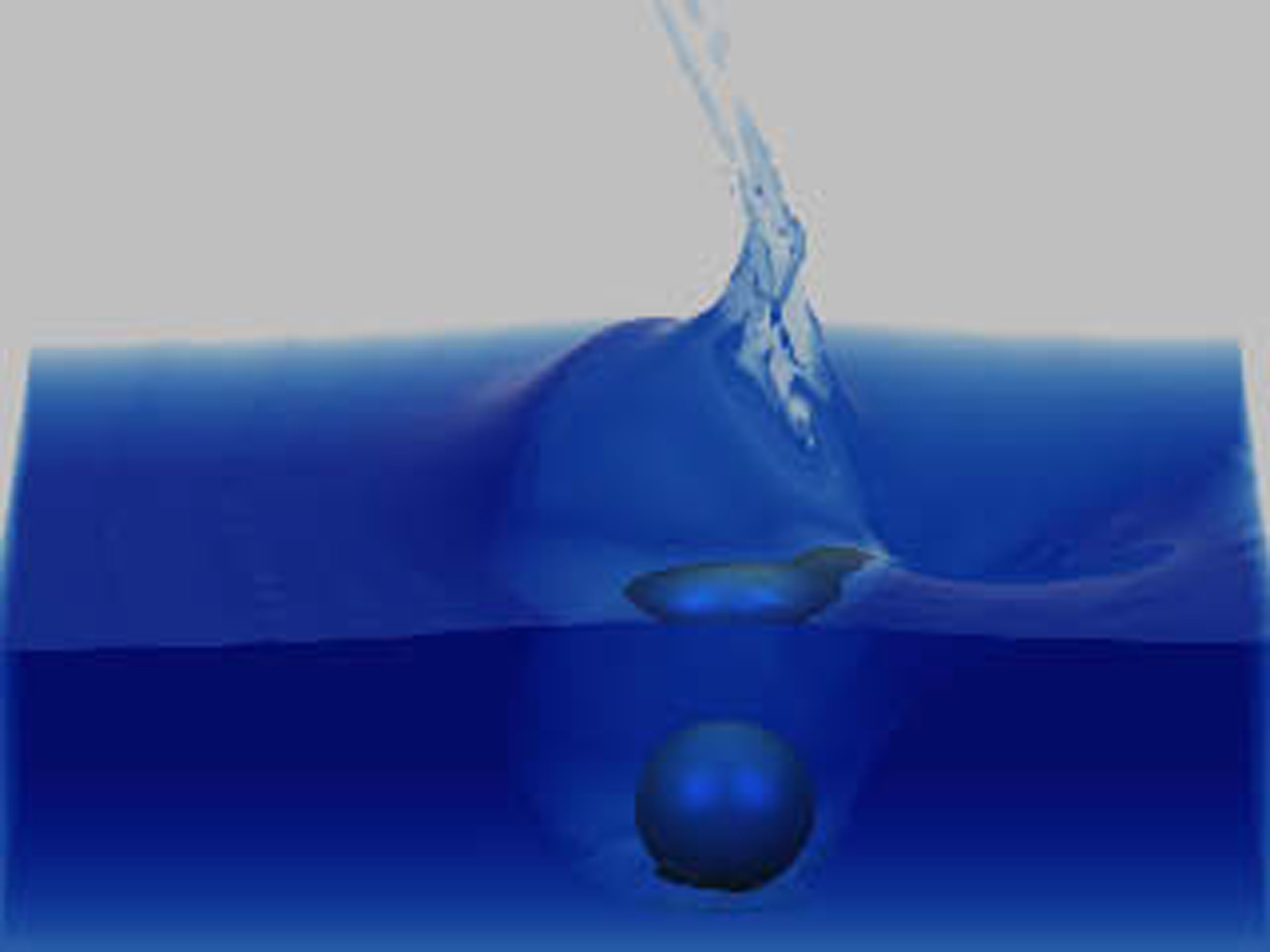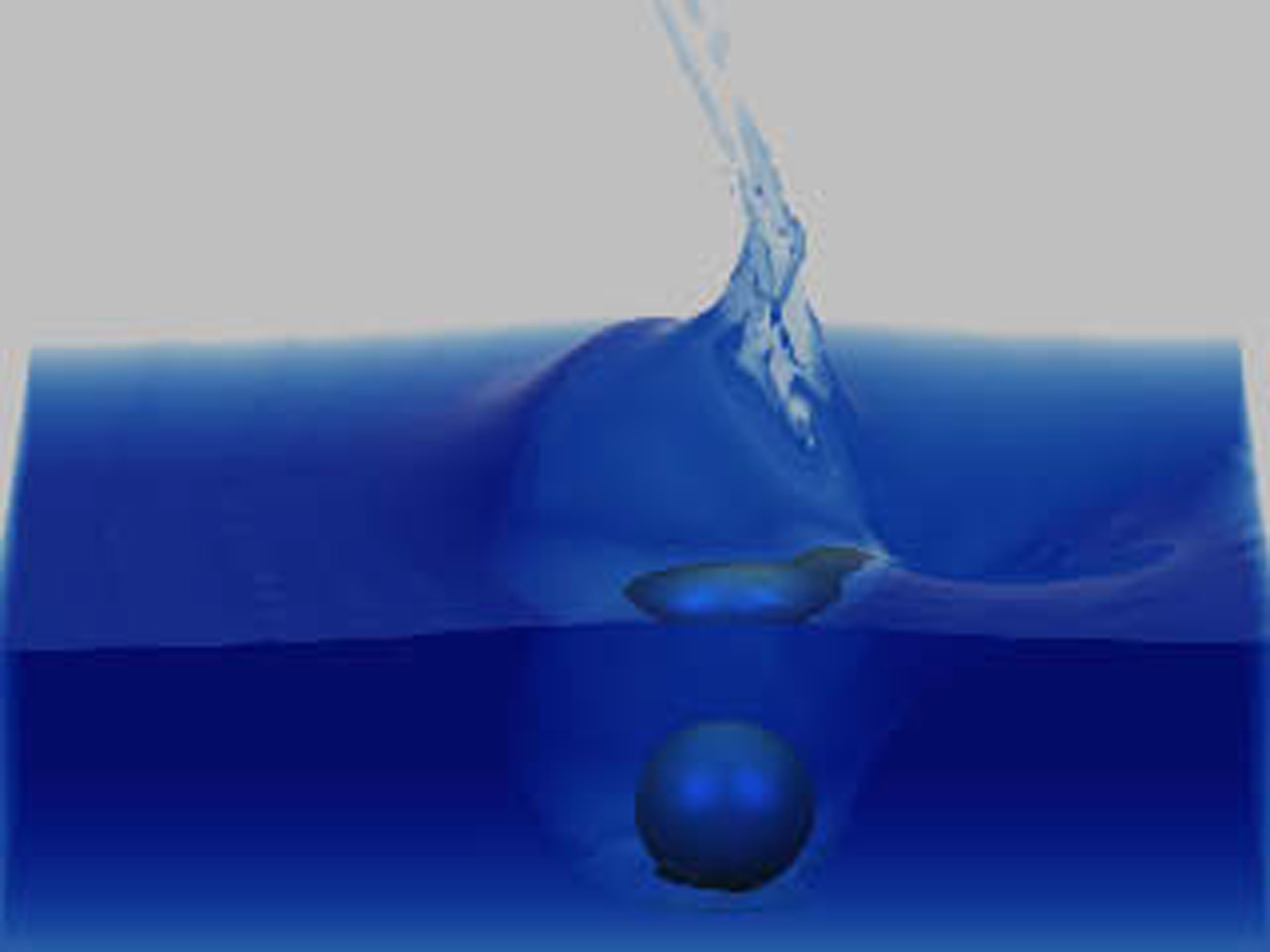“Animation and rendering of complex water surfaces” by Enright, Marschner and Fedkiw
Conference:
Type(s):
Title:
- Animation and rendering of complex water surfaces
Presenter(s)/Author(s):
Abstract:
We present a new method for the animation and rendering of photo-realistic water effects. Our method is designed to produce visually plausible three dimensional effects, for example the pouring of water into a glass (see figure 1) and the breaking of an ocean wave, in a manner which can be used in a computer animation environment. In order to better obtain photorealism in the behavior of the simulated water surface, we introduce a new “thickened” front tracking technique to accurately represent the water surface and a new velocity extrapolation method to move the surface in a smooth, water-like manner. The velocity extrapolation method allows us to provide a degree of control to the surface motion, e.g. to generate a windblown look or to force the water to settle quickly. To ensure that the photorealism of the simulation carries over to the final images, we have integrated our method with an advanced physically based rendering system.
References:
1. ADALSTEINSSON, D., AND SETHIAN, J. 1999. The fast construction of extension velocities in level set methods. J. Comp. Phys. 148, 2-22. Google Scholar
2. CHEN, J., AND LOBO, N. 1994. Toward interactive-rate simulation of fluids with moving obstacles using the navier-stokes equations. Computer Graphics and Image Processing 57, 107-116. Google Scholar
3. CHEN, S., JOHNSON, D., AND RAAD, P. 1995. Velocity boundary conditions for the simulation of free surface fluid flow. J. Comp. Phys. 116, 262-276. Google Scholar
4. CHEN, S., JOHNSON, D., RAAD, P., AND FADDA, D. 1997. The surface marker and micro cell method. Int. J. for Num. Meth. in Fluids 25, 749-778.Google Scholar
5. ENRIGHT, D., FEDKIW, R., FERZIGER, J., AND MITCHELL, I. 2002. A hybrid particle level set method for improved interface capturing. J. Comp. Phys. To appear. Google Scholar
6. FOSTER, N., AND FEDKIW, R. 2001. Practical animation of liquids. In Proceedings of SIGGRAPH 2001, ACM Press / ACM SIGGRAPH, E. Fiume, Ed., Computer Graphics Proceedings, Annual Conference Series, ACM, 23-30. Google Scholar
7. FOSTER, N., AND METAXAS, D. 1996. Realistic animation of liquids. Graphical Models and Image Processing 58, 471-483. Google Scholar
8. FOURNIER, A., AND REEVES, W. T. 1986. A simple model of ocean waves. In Computer Graphics (Proceedings of SIGGRAPH 86), 20(4), ACM, 75-84. Google Scholar
9. HARLOW, F., AND WELCH, J. 1965. Numerical calculation of time-dependent viscous incompressible flow of fluid with free surface. Phys. Fluids 8, 2182-2189.Google Scholar
10. HECKBERT, P. S. 1990. Adaptive radiosity textures for bidirectional ray tracing. In Computer Graphics (Proceedings of SIGGRAPH 90), vol. 24, ACM, 145-154. Google Scholar
11. HILTZIK, M. A., AND PHAM, A. 2001. Synthetic actors guild. Los Angeles Times. May 8, 2001, natl. ed.: A1+.Google Scholar
12. HIRT, C., AND NICHOLS, B. 1981. Volume of fluid (VOF) method for the dynamics of free boundaries. J. Comp. Phys. 39, 201-225.Google Scholar
13. JENSEN, H. W. 1995. Importance driven path tracing using the photon map. In Eurographics Rendering Workshop 1995, 326-335.Google Scholar
14. JENSEN, H. W. 2001. Realistic Image Synthesis Using Photon Maps. A K Peters. Google Scholar
15. JIANG, G.-S., AND PENG, D. 2000. Weighted eno schemes for hamilton-jacobi equations. SIAM J. Sci. Comput. 21, 2126-2143. Google Scholar
16. KAJIYA, J. T. 1986. The rendering equation. In Computer Graphics (Proceedings of SIGGRAPH 86), vol. 20, 143-150. Google Scholar
17. KASS, M., AND MILLER, G. 1990. Rapid, stable fluid dynamics for computer graphics. In Computer Graphics (Proceedings of SIGGRAPH 90), vol. 24, ACM, 49-57. Google Scholar
18. LAFORTUNE, E. P., AND WILLEMS, Y. D. 1993. Bi-directional path tracing. In Proceedings of Compugraphics ’93, 145-153.Google Scholar
19. MARSCHNER, S., AND LOBB, R. 1994. An evaluation of reconstruction filters for volume rendering. In Proceedings of Visualization 94, IEEE Comput. Soc. Press, 100-107. Google Scholar
20. MASTEN, G., WATTERBERG, P., AND MAREDA, I. 1987. Fourier synthesis of ocean scenes. IEEE Computer Graphics and Application 7, 16-23. Google Scholar
21. MILLER, G., AND PEARCE, A. 1989. Globular dynamics: A connected particle system for animating viscous fluids. Computers and Graphics 13, 3, 305-309.Google Scholar
22. NISHITA, T., AND NAKAMAE, E. 1994. Method of displaying optical effects within water using accumulation buffer. In Proceedings of SIGGRAPH 94, ACM SIGGRAPH / ACM Press, Computer Graphics Proceedings, Annual Conference Series, ACM, 373-381. Google Scholar
23. O’BRIEN, J., AND HODGINS, J. 1995. Dynamic simulation of splashing fluids. In Proceedings of Computer Animation 95, 198-205. Google Scholar
24. OSHER, S., AND FEDKIW, R. 2002. The Level Set Method and Dynamic Implicit Surfaces. Springer-Verlag, New York.Google Scholar
25. OSHER, S., AND SETHIAN, J. 1988. Fronts propagating with curvature dependent speed: Algorithms based on hamiliton-jacobi formulations. J. Comp. Phys. 79, 12-49. Google Scholar
26. PEACHEY, D. R. 1986. Modeling waves and surf. In Computer Graphics (Proceedings of SIGGRAPH 86), 20(4), ACM, 65-74. Google Scholar
27. PREMOZE, S., AND ASHIKHMIN, M. 2000. Rendering natural waters. In The proceedings of Pacific Graphics 2000, 23-30. Google Scholar
28. RADOVITZKY, R., AND ORTIZ, M. 1998. Lagrangian finite element analysis of newtonian fluid flows. Int. J. Numer. Meth. Engng. 43, 607-619.Google Scholar
29. SCHACHTER, B. 1980. Long crested wave models. Computer Graphics and Image Processing 12, 187-201.Google Scholar
30. SETHIAN, J. 1999. Level Set Methods and Fast Marching Methods. Cambridge University Press. Google Scholar
31. STAM, J. 1999. Stable fluids. In Proceedings of SIGGRAPH 99, ACM SIGGRAPH / Addison Wesley Longman, Computer Graphics Proceedings, Annual Conference Series, ACM, 121-128. Google Scholar
32. TERZOPOULOS, D., PLATT, J., AND FLEISCHER, K. 1989. Heating and melting deformable models (from goop to glop). In Graphics Interface ’89, 219-226.Google Scholar
33. TESSENDORF, J. 2001. Simulating ocean water. In Simulating Nature: Realistic and Interactive Techniques. SIGGRAPH 2001 Course Notes 47.Google Scholar
34. TS’O, P. Y., AND BARSKY, B. A. 1987. Modeling and rendering waves: Wave-tracing using beta-splines and reflective and refractive texture mapping. ACM Transactions on Graphics 6, 3, 191-214. Google Scholar
35. UNVERDI, S.-O., AND TRYGGVASON, G. 1992. A front-tracking method for viscous, incompressible, multi-fluid flows. J. Comp. Phys. 100, 25-37. Google Scholar
36. VEACH, E., AND GUIBAS, L. J. 1994. Bidirectional estimators for light transport. In Eurographics Rendering Workshop 1994 Proceedings, 147-162.Google Scholar
37. VEACH, E., AND GUIBAS, L. J. 1997. Metropolis light transport. In Proceedings of SIGGRAPH 97, ACM SIGGRAPH / Addison Wesley, Computer Graphics Proceedings, Annual Conference Series, ACM, 65-76. Google Scholar
38. WATT, M. 1990. Light-water interaction using backward beam tracing. In Computer Graphics (Proceedings of SIGGRAPH 90), vol. 24, ACM, 377-385. Google Scholar





